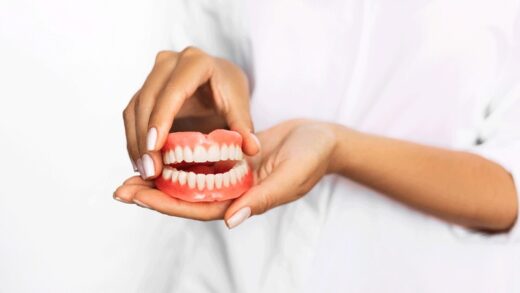When we think of dental prosthesis, most of us think of the unsympathetic images that our grandparents used, put on and took off, and put in water at night, right? There is more than that…
Prosthodontics
It is a combination of the word “prosto” meaning “to put in place” and “odonti” meaning “teeth”. The prosthodontist; he is the specialist who can help you when you need to make any changes in your mouth, from a single tooth to all teeth.
Today, with the developing technology, we share more information. Dentists often adopt multidisciplinary treatment approaches. In addition, your doctor will evaluate your oral health. So this results in much more accurate, quality and results that can meet higher patient expectations.
The prosthodontist in this team; It exists as a “smile architect” who evaluates beauty, function and naturalness. But also in terms of gums, lips and facial characteristics; They plan and implement all treatments together with other specialists. Maxillofacial surgeon, endodontist (canal treatment specialist). Orthodontist (wire treatment specialist). Periodontologist (gingival specialist) and technician team.
What Are These Treatments of Dental Prosthesis?
- Smile design applications
- Lamina Veneer applications
- Computer aided applications
- Implant planning and superstructure applications (fixed, removable and screwed prostheses)
- Partial crowns such as inlays and onlays
- Aesthetic restorations such as glass ceramic and zirconia
- Total Dentures – palatal prostheses
- Precision-retained – snap-in prostheses
- Protective dental plaques (night plaques, sports plaques)
- Diagnosis and treatment of jaw joint disorders
- Maxillofacial prostheses (obturator, eye-ear prostheses, snoring apparatus)
- Prosthetic dental treatments of geriatric (advanced elderly) patients
What is Full Dental Prosthesis (Total Dentures)?
They are classical prosthetic methods applied to edentulous jaws, supported by soft tissues and wrapping the jawbones like a saddle.
How Are Full Dental Prosthesis (Total Prostheses) Made?
When the patient have no teeth, it is procedure experts choose. These are prostheses that are taken with measuring spoons specially prepared for the patients. It takes about a week for your doctor to complete soft tissue adaptation of the prostheses. It may take longer. However, if your treatment stay prolonged, you will exceed your adaptation process. Especially by working cooperatively between the patient and the doctor. The retention of these prostheses with minimum comfort in the patient’s mouth depends entirely on the amount and density of bone and gums.
What are Precision Attachment Prostheses?
Your doctor will do this if you have a partial tooth deficiency. Both hard tissues and soft tissues support these prostheses. They have a very high retention and comfort. Prostheses were developed to hide the hooks and took the form of sensitive connection. Due to its sensitive connections. It is known as the “prosthesis with snaps” among the people.
How Are Precision Attachment Prostheses Made?

Metal-supported porcelain is implemented to the existing teeth. The male parts of sensitive connections are designed to be on metal-supported porcelain. Afterwards, moving parts are designed by taking measurements over these designs. These prostheses, whose soft tissue adaptation is much faster than full dentures, have different types of sensitive connections. In addition to this, the treatment is completed by choosing the most suitable connection type for the patient. It is very suitable for transitional prostheses. It is recommended especially for the individuals who will use prostheses for the first time.
What are Hybrid Dental Prostheses?
They are prostheses designed for implant tops. These prosthesis applications, which are preferred according to the implant applications planned depending on the intraoral bone volume of the patients; They are the most comfortable methods for edentulous patients.
How Are Hybrid Dental Prostheses Made?
Your sessions last two weeks in total. We secure our prostheses (except implant treatments) to the implants of our patients who have special internal screws. In addition, we plan them in such a way that they cannot be removed outside the clinical environment. They are the selected prostheses depending on the bone and mouth structure and are the most cpnvenient among the removable prostheses. They do not move in the patient’s mouth unless our physicians remove it. These prostheses restore the lost vertical dimension, also prevent your cheeks and lips from collapsing and give a fuller appearance.
There are cases that can be completed within 48 hours, depending on the patient’s condition. With the “all on 4” (to know more about all on 4 technique please click here !)concept suitable for the selected implant, we can take your measurements on the time we place the implants and put your temporary prosthesis in your mouth. Thus, we can continue our treatment without leaving our patient toothless.
To know more about dental prosthesis, please reach us via our website
Frequently Asked Questions
What are some examples of dental prosthetics?
There are several examples of dental prostheses. These are; dentures, palatal obturator, crown, partial denture, dental implant, bridge, orthodontic appliance.
What is a fixed dental prosthesis?
Fixed dental prosthesis are a procedure which is applied when there is damaged or missing teeth.
What is the difference between implant and prosthesis?
Implant is a procedure which is inserted surgically. Beyond that prosthesis is an artificial item which replaces a missing tooth.
